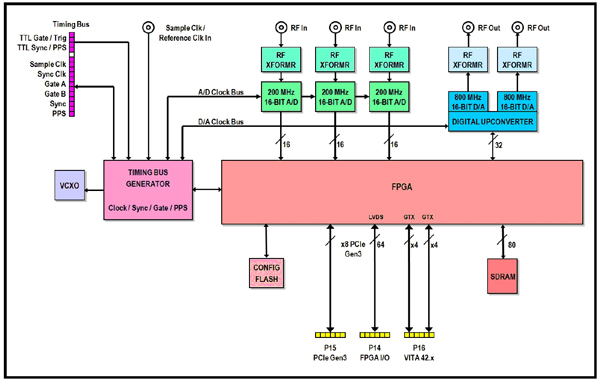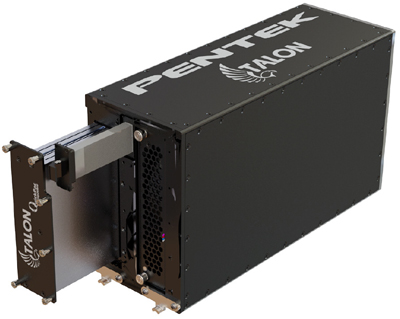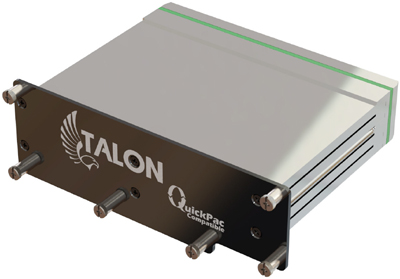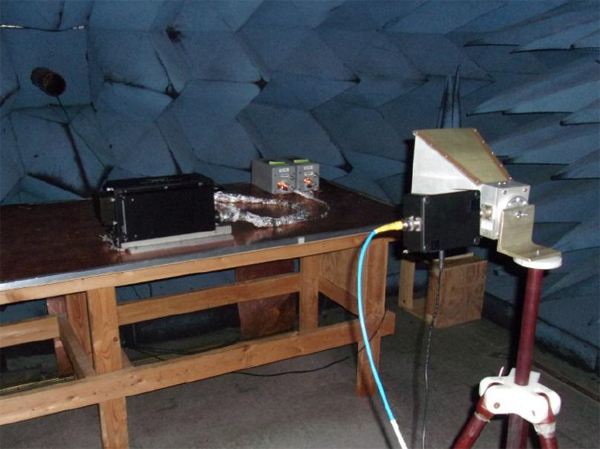- PRODUCTS
- RECORDERS
- SUPPORT
| Home > Tutorials > Development tactics and techniques for SFF RF Signal Recorders |

This article discusses the engineering considerations and design techniques used to develop a small form factor (SFF) rugged recorder that can handle the extremely high data rates associated with very wide bandwidth RF signal recording. It is intended to provide engineers with ideas on how to bring this capability into confined and often extreme environments while focusing on military specification compliance, SWaP, and ease of use with confidence.
The ability to record wideband RF signals in real time is a critical part of the development of radar, signal intelligence, beamforming and electronic warfare systems. Wideband RF downconverters are now capable of translating a gigahertz of RF bandwidth to intermediate frequencies (IF) with excellent dynamic range. These signals require high performance A/D converters with high enough sample rates and bit resolution to sample the entire band effectively.

A/D converters, paired with the latest FPGA technology in an XMC form factor, provide a signal conversion and processing engine that can sample signals at extremely high data rates in a small package suitable for a small form factor recorder. These XMC modules serve as the recorder's front-end interface and are used to move multiple gigabytes per second of data through the system.
XMC modules are commonly available with A/D converters that have maximum sample rates ranging from 200 MS/s (2 million samples per second) to 6.4 GS/s (6.4 billion samples per second). The sample rate of the A/D converter dictates the maximum RF signal bandwidth that can be sampled and recorded. For example, a 200 MS/s A/D converter with an 80% anti-aliasing filter can record 80 MHz of signal bandwidth, while a 6.4 MS/s A/D converter with a similarly shaped filter can record over 2.5 GHz of signal bandwidth. Some applications require a very wide bandwidth signal to be captured, while others require the ability to capture several channels of narrower band signals, so it is important to provide an array of A/D converter offerings in an XMC form factor to support our SFF signal recorder.
While the A/D sample rate is important for selecting the front end of a recorder, the dynamic range of the A/D is equally important to effectively match each application's requirement. For an RF signal recorder, dynamic range can be described as the ratio between the largest and smallest signals that can be recorded successfully. Some signal acquisition scenarios require the ability to record very small signals in the presence of potentially very large signals, requiring an A/D converter with excellent dynamic range.
The bit resolution of the A/D converter and the effective number of bits (ENOB) help to express dynamic range to the user. However, A/D converter specifications like spur free dynamic range (SFDR) and signal to noise ratio (SNR) provide an even more useful way to present dynamic range.
High performance 200 MS/s A/D converters provide 16 bits of resolution and offer SFDR specifications greater than 85 dBFS and SNR specifications greater than 75 dBFS, while 6.4 MS/s A/D converters provide 12 bits of resolution and offer SFDR closer to 65 dBFS and SNR closer to 55 dBFS. Typically, the higher the sample rate of the A/D converter, the lower the dynamic range, so it is important to provide a wide array of A/D converters on XMC modules to cover different types of applications.
FPGAs coupled with A/D converters on XMC modules provide an excellent digital signal processing engine for the recorder. Digital downconverters, signal detection, radar gating, and acquisition time stamping are common processing capabilities that are often provided in standard FPGA IP designs. A well-developed set of FPGA IP modules greatly enhances the capabilities of an RF signal recorder.
D/A converters are often included on XMC modules to allow users to play back acquired signals or generate radar pulses. Multi-channel A/D and D/A XMC modules provide phase coherency across all channels. This is an essential capability of any real-time signal recorder.
Extremely small Global Navigation Satellite System (GNNS) receivers have emerged over the last few years with support for Galileo, GPS, and Glonass systems. These small receivers support timestamping of acquired data with nanosecond precision. The receivers provide 10 MHz reference clocks and PPS signals to the recorder's XMC modules to allow users to capture the exact timing of gated or triggered events.
GNNS receivers also allow systems to record the latitude, longitude, and altitude of the recorder for logging flight paths, vehicle movement, or static ground location, if required. GNNS receivers often provide options for oven-controlled oscillators for operation across a wide range of temperatures and accelerometers to improve time and position accuracy during rapid acceleration, allowing them to operate in a wide range of environments.
Drive Packs Simplify High Capacity Data StorageStreaming data to disk in real-time at rates in the gigabytes per second has been achievable in large rackmount recorders by striping data over a RAID array of many SSDs. High-performance RAID controllers not only provide lightning-fast write speeds but offer redundancy, protecting against the rare but disastrous disk failure that could occur during a mission. RAID controllers also utilize SSD features to provide data encryption and secure erase capabilities. Another feature typically seen in rackmount recorders is front panel removable drives. An array of as many as 48 drives, mounted to sleds, can be inserted and removed individually from the front of the system. This allows users to remove all recorded data while allowing the recorder to remain mounted in a rack. It also allows users to maintain multiple sets of drive arrays to minimize downtime between missions. The challenge of maintaining the features and performance of larger form factor recorders is facilitated by the growing solid state storage demand driven by data centers. V-NAND flash technology has enabled solid state drive capacity and write rates to continue to increase in very small package sizes. These inherent advances in solid state technology provide a path for shrinking the data storage array, allowing simpler and smaller designs with performance and features equal to those of far larger systems. Small drive packs, containing an array of solid state devices, provide storage speed and capacity previously only available with many individually removable SSDs. By designing the packaging of a storage array into a drive pack, the job of managing a high drive-count system is replaced with the job of managing a single drive pack, providing a tremendous easeof-use benefit. A single high-insertion-cycle connector designed into the drive pack provides a far more reliable mechanism for the removable storage media than the standard SATA connectors typically available in rackmount systems. Well-designed drive packs are capable of holding tens of terabytes of data and are capable of storage speeds in the gigabytes per second. Drive packs must be designed for easy removal while the recorder remains mounted in the vehicle or aircraft. |
 Figure 2. Pentek's QuickPac™ drive pack provides solid state storage in a small package. These pictures show the QuickPac drive pack and OS drive removed and partially ejected from the Talon Model RTX 2589 3.6 GS/sec Ultra Wideband RF/IF Extreme 1/2 ATR Recorder. 
|
MIL-STD-810, Environmental Engineering Considerations and Laboratory Tests, is a United States military standard that emphasizes tailoring equipment's environmental design and test limits for the conditions that it will experience throughout its service life. The standard also establishes test chamber methods that replicate the effects of environments on the equipment rather than imitating the environments themselves.
MIL-STD-810 addresses a broad range of environmental conditions that include: low pressure for altitude testing; exposure to high and low temperatures plus temperature shock (both operating and in storage); rain (including windblown and freezing rain); humidity, fungus, salt fog for rust testing; sand and dust exposure; explosive atmosphere; leakage; acceleration; shock and transport shock; gunfire vibration; and random vibration. The standard describes environmental management and engineering processes that can be of enormous value to generate confidence in the environmental worthiness and overall durability of a system design. (Wikipedia, 2018)
While operating environments vary greatly, meeting as many criteria in the MIL-STD-810 specification as possible is imperative to providing a reliable and robust product. Anodized metal with form-in-place gaskets allows for sealed protection against rain, humidity, fungus, salt fog, and sand and dust exposure. CAD software provides simulation analysis tools to assist with thermal design and structural integrity. Well-executed design techniques help assure a smooth laboratory testing process.
MIL-STD-461 is another popular military specification requirement for RF signal recorders. MIL-STD-461 provides the requirements for the control of electromagnetic interference (EMI) emissions and susceptibility characteristics of electronic, electrical, and electromechanical equipment and subsystems designed or procured for use by activities and agencies of the Department of Defense (DoD). (NTS, 2018)

RF test laboratories use anechoic chambers to run a series of MIL-STD-461 tests that include radiated emissions, radiated susceptibility, conducted emissions, and conducted susceptibility for a range of frequencies. It is typical to cover a radiated range up to 18 GHz and a conducted range up to 10 MHz on power leads.
It is important to take the appropriate design steps to meet MIL-STD-461 compliance since iterative independent laboratory testing becomes very expensive. Design techniques used to control EMI include the use of RF emission filters and RF gaskets to prevent radiated electromagnetic emission and susceptibility. Additionally, an in-line EMI power filter designed for the internal power supply can be used to protect against conducted emission and susceptibility.
Designed using the techniques described in this article, Pentek offers the Talon RTX SFF product line. Figures 6, 7, and 8 present different views of the Talon RTX SFF recorder.
All Talon RTX SFF Recorders include the Pentek SystemFlow® recording software. SystemFlow features a Windows based GUI that provides a simple means to configure and control the recorder. SystemFlow includes signal viewing and analysis tools, that allow the user to monitor input signals prior to, during, and after a recording session. These tools include a virtual oscilloscope, a spectrum analyzer and spectrogram displays.
| CONNECT ON SOCIAL: |
|
|
|
|